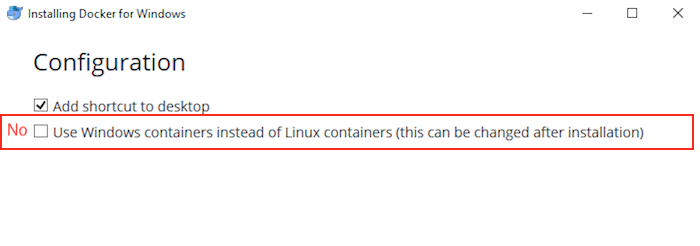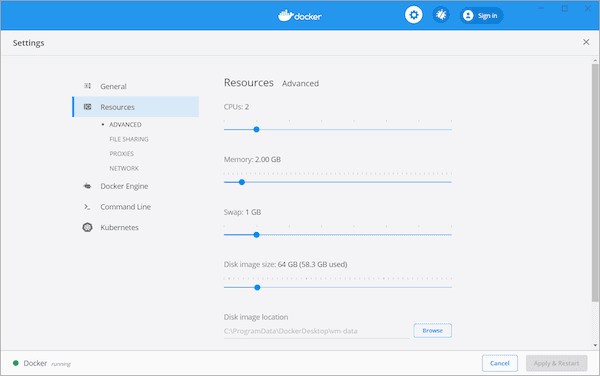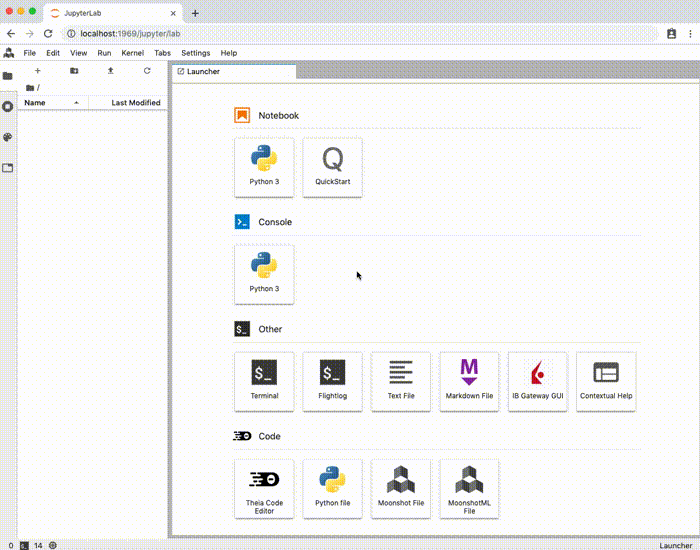Installation Tutorial for Windows
QuantRocket runs on Docker, so installing QuantRocket is a two-part process:
- install Docker
- install QuantRocket
Install Docker Desktop
Visit Docker's website and follow the instructions to download and install Docker Desktop on your computer.
If prompted during installation, do not check the box to use Windows containers. Docker Desktop for Windows can run Windows containers or Linux containers but not both at the same time. QuantRocket uses Linux containers.

After the installation, start Docker Desktop if it isn't already started (Start > Docker).
To verify the installation, open PowerShell (click Start and type "powershell") and run:
$ docker run hello-worldAdjust Docker's memory setting
By default, Docker Desktop uses 2 GB of your system memory. Giving Docker at least 4 GB of memory is recommended for QuantRocket. Generally, reserve at least 4 GB for your operating system or your computer might be sluggish. This means your computer should have a minimum of 8 GB of memory. If you plan to collect minute data, 8-12 GB is recommended for Docker (12-16 GB total). The more memory you give Docker, the larger the backtests and data analysis you can do.
Find and right-click the Docker icon in the notification area, then click Settings.
![]()
Click Resources -> Advanced and adjust the Memory slider to the desired position.

Install QuantRocket
To install QuantRocket, download a Docker Compose file which tells Docker how to create the QuantRocket stack. A Compose file is a YAML file that defines a multi-container Docker application.
Open PowerShell on Windows (click Start and type "powershell").
Create a folder for QuantRocket under your home directory:
$ cd ~
$ mkdir quantrocket
$ cd quantrocketCopy and paste the following command to download the latest Compose file and save to your computer:
$ curl 'https://www.quantrocket.com/composefiles/latest/local/docker-compose.yml' -o docker-compose.yml(You can also download the Compose file from the downloads page.)
Now, use docker-compose to deploy QuantRocket:
$ cd ~/quantrocket
$ docker-compose -p quantrocket up -dDocker Compose will read your docker-compose.yml, pull the images down from Docker Hub, and create and run containers from the images. This process takes 5-15 minutes. You will see output like this:
Creating network "quantrocket_default" with the default driver
Pulling houston (quantrocket/houston:0.8.0)...
ad74af05f5a2: Pull complete
c1da3f388f16: Extracting [============================================> ] 110.3MB/125.3MB
3f388f16: Downloading [===========================================> ] 108MB/125.3MBte
4c2b7a4aefc0: Download complete
e61a44100a50: Download complete
8e960303c169: Waiting
f2a1d6599d9d: WaitingYou can list all the containers that are running:
$ docker psCONTAINER ID IMAGE COMMAND CREATED STATUS PORTS NAMES
476bd8607707 quantrocket/history:0.2.6 "/usr/bin/tini -- ..." 37 seconds ago Up 33 seconds 80/tcp quantrocket_history_1
96e93387015c quantrocket/master:0.2.11 "/usr/bin/tini -- ..." 37 seconds ago Up 32 seconds 80/tcp quantrocket_master_1
fc4b87285158 quantrocket/jupyter:4.4.0.7 "/usr/bin/tini -- ..." 38 seconds ago Up 33 seconds 80/tcp quantrocket_jupyter_1
...You can now access the Jupyter environment in your browser at:
You may want to bookmark this URL.
In JupyterLab you'll see the JupyterLab dashboard. Click the Quickstart button to find an interactive tour and other resources to help you get started with QuantRocket:
